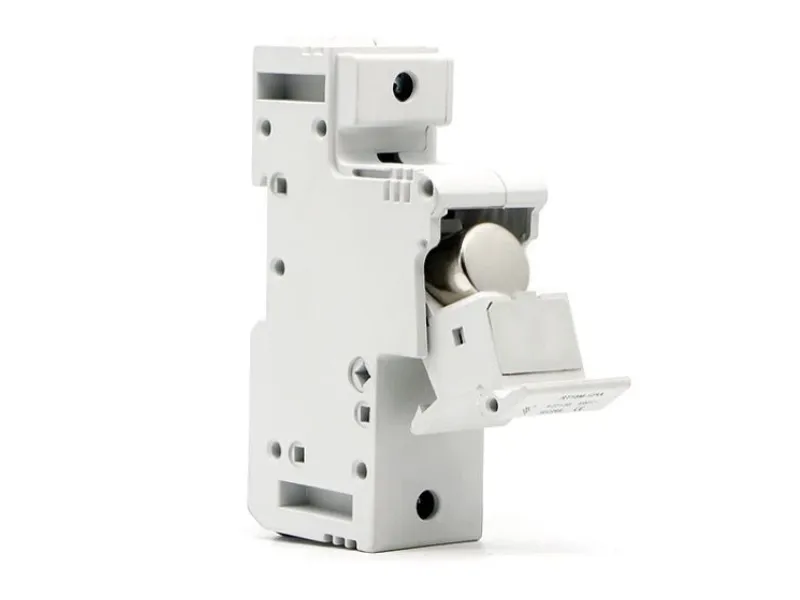Memahami perbezaan kritikal antara fius AC dan DC bukan sahaja mengenai teori elektrik—ia mengenai mencegah kegagalan bencana, kebakaran dan kerosakan peralatan. Dengan pertumbuhan letupan pemasangan solar, kenderaan elektrik dan sistem bateri, pemilihan jenis fius yang betul telah menjadi lebih kritikal berbanding sebelum ini.
Barisan Bawah Di Depan: Fius AC dan DC TIDAK boleh ditukar ganti. Menggunakan fius AC dalam litar DC boleh menyebabkan arka berterusan, bahaya kebakaran dan kegagalan peralatan kerana fius DC memerlukan teknologi kepupusan arka khusus yang tidak ada pada fius AC.
Perbezaan Asas: Mengapa Aliran Semasa Penting
Fius AC: Mengambil Kelebihan Sifar-Crossing
Sistem AC secara semula jadi membalikkan aliran arus 100-120 kali sesaat (50-60Hz), mewujudkan titik silang sifar di mana arus turun kepada sifar volt. Fenomena semulajadi ini adalah senjata rahsia fius AC.
Apabila elemen fius AC cair semasa keadaan arus lebih, aliran arus sifar menjadikannya sangat mudah untuk fius untuk mengganggu litar-pada ketika ini, aliran arus berhenti dan tiada lagi tenaga untuk mengekalkan arka merentasi elemen fius cair.
Ciri-ciri Fius AC:
- Pembinaan mudah dengan reka bentuk filamen asas
- Badan kaca atau seramik dengan struktur dalaman yang ringkas
- Saiz fizikal yang lebih kecil
- Kos yang lebih rendah kerana reka bentuk yang lebih ringkas
- Bergantung pada lintasan sifar semula jadi untuk kepupusan arka
Fius DC: Melawan Arus Berterusan
DC boleh menjadi sangat sukar untuk fius dipecahkan kerana arus mengalir dalam satu arah tanpa titik sifar untuk membantu fius memadamkan arka. Ini mewujudkan cabaran asas yang menjadikan DC menggabungkan peranti yang lebih canggih.
Apabila fius DC beroperasi, plasma boleh membentuk dan meneruskan arus kerana tiada lintasan sifar semula jadi untuk membantu memadamkan arka. Arus DC hanya boleh bergantung pada arka untuk memadamkan dirinya dengan cepat di bawah kesan penyejukan paksa pengisi pasir kuarza, yang jauh lebih sukar daripada memecahkan arka AC.
Ciri-ciri Fius DC:
- Peranti canggih dengan pembinaan berbeza berbanding fius AC ringkas, mengandungi elemen tambahan untuk memadamkan arka
- Reka bentuk yang diisi pasir atau selongsong yang diperkukuh untuk penyingkiran arka
- Saiz fizikal yang lebih besar untuk penilaian yang setara
- Kos yang lebih tinggi disebabkan pembinaan yang kompleks
- Mekanisme penindasan arka aktif diperlukan
Perbezaan Pembinaan Kritikal
Saiz dan Reka Bentuk Fizikal
Fius DC dengan kadaran voltan dan arus yang sama biasanya lebih panjang daripada fius AC untuk memastikan terdapat jarak yang cukup untuk mengurangkan tenaga arka. Ini bukan hanya butiran kecil—ia adalah keperluan keselamatan.
Keperluan Saiz mengikut Voltan:
- Untuk setiap peningkatan 150V dalam voltan DC, panjang badan fius hendaklah dinaikkan sebanyak 10mm
- Apabila voltan DC ialah 1000V, badan fius hendaklah 70mm
- Apabila voltan DC mencapai 10-12KV, badan fius hendaklah sekurang-kurangnya 600-700mm
Teknologi Kepupusan Arka
Fius AC:
- Kaca atau seramik ringkas dengan filamen asas
- Penindasan arka minimum diperlukan kerana lintasan sifar
- Pembinaan seramik standard yang dipenuhi udara atau asas
Fius DC:
- Reka bentuk yang dipenuhi pasir untuk penghapusan arka
- Spring kecil di dalam yang membantu menarik hujungnya apabila unsur cair
- Pengisi pasir kuarza dengan nisbah saiz zarah dan ketulenan tertentu
- Mekanisme penyejukan yang dipertingkatkan dan ruang arka yang lebih panjang
Spesifikasi Bahan
Reka bentuk yang munasabah dan kaedah kimpalan kepingan lebur, nisbah ketulenan dan saiz zarah pasir kuarza, takat lebur, dan kaedah pengawetan menentukan keberkesanan prestasi fius DC.
Perbezaan Kadar Voltan dan Arus
Peraturan Derating
Garis Panduan Keselamatan Kritikal: Fius AC standard perlu dikurangkan sebanyak 50 peratus untuk kegunaan DC—iaitu, 1000V AC akan dinilai pada 500V DC untuk selamat.
Contoh Perbandingan:
- Fius dinilai untuk 250VAC tetapi hanya 32VDC
- Fius AC berkadar 380V hanya boleh digunakan dalam litar DC 220V
- Fius 600VAC berkemungkinan mempunyai penarafan DC setara yang lebih hampir kepada 300V
Mengapa Penarafan DC Lebih Rendah
Dalam litar DC, arus tidak melalui sifar, jadi tenaga arka semasa gangguan litar adalah dua kali ganda daripada litar AC. Prinsip fizik asas ini mendorong keperluan untuk penarafan voltan DC yang lebih konservatif.
Julat Penilaian Biasa:
- Fius AC: 65V, 125V, 250V, 500V, 690V, 12KV sehingga 40.5KV
- Fius DC: 12V, 32V, 500VDC, 1000VDC, 1500VDC atau voltan tersuai yang lebih tinggi
Mengapa Fius AC dan DC TIDAK Boleh Ditukar
Kebenaran Berbahaya Mengenai Menggunakan Fius AC dalam Litar DC
Jangan sekali-kali Gunakan Fius AC dalam Aplikasi DC. Inilah sebabnya:
- Risiko Mengekalkan Arka: Fius AC mungkin tidak dapat mengganggu arus DC dengan betul, membawa kepada arka dan potensi bahaya
- Bahaya Kebakaran: Menggunakan fius AC dalam litar DC akan menyebabkan arka tidak dipadamkan dengan selamat dan boleh menyebabkan situasi kebakaran
- Kerosakan Peralatan: Penarafan voltan fius AC mungkin tidak sesuai untuk litar DC, yang boleh mengakibatkan kerosakan penebat atau bahkan letupan fius
- Arka Berterusan: DC boleh terus mengalir dalam plasma unsur bercantum sejat pada voltan tinggi di mana AC akan sentiasa dihentikan selepas satu kitaran
Menggunakan Fius DC dalam Aplikasi AC
Fius berkadar DC boleh berfungsi dengan AC atau DC, tetapi fius berkadar AC mungkin tidak memadamkan arka DC. Walaupun lebih selamat daripada senario terbalik, menggunakan fius DC dalam aplikasi AC biasanya tidak diperlukan dan lebih mahal.
Aplikasi Dunia Sebenar
Aplikasi Fius AC
Sesuai untuk:
- Panel elektrik kediaman
- Pengagihan kuasa komersial
- Litar kawalan motor (dengan saiz yang betul)
- Sistem pencahayaan standard
- Perkakas rumah
- Sistem kuasa AC bersambung grid
Aplikasi Fius DC
Penting untuk:
- Sistem fotovoltaik solar (kotak penggabung tali, kotak tatasusunan, penyongsang sisi DC)
- Stesen mengecas kenderaan elektrik
- Sistem sandaran bateri
- Peralatan telekomunikasi
- Sistem elektrik marin
- Pemacu motor DC industri
- Aplikasi automotif (sistem 12V-42V)
Sistem PV Suria: Aplikasi Kritikal
Dalam sistem suria yang terdiri daripada berbilang rentetan modul fotovoltaik, rentetan dilindungi menggunakan pautan fius DC yang dipasang dalam kotak simpang penggabung atau tatasusunan.
Keperluan Khusus PV:
- Fius berkadar DC yang direka khusus untuk aplikasi PV bertujuan untuk pecah pada arus undian dalam masa yang singkat, memberikan perlindungan maksimum untuk kabel, kotak simpang dan modul PV
- Arus dihadkan oleh reka bentuk sumber arus malar bagi modul PV, jadi mendapatkan arus yang mencukupi untuk memecahkan fius berkadar AC dalam jumlah masa yang munasabah mungkin agak sukar.
Piawaian dan Pensijilan Industri
IEC 60269-6 Standard untuk Aplikasi PV
Suruhanjaya Elektro-teknikal Antarabangsa (IEC) mengiktiraf bahawa perlindungan sistem PV adalah berbeza untuk pemasangan elektrik standard, dicerminkan dalam piawaian IEC 60269-6 (gPV), yang mentakrifkan ciri khusus yang perlu dipenuhi oleh pautan fius untuk melindungi sistem PV.
Ciri-ciri Standard Utama:
- Meliputi pautan fius untuk melindungi rentetan dan tatasusunan fotovoltaik dalam litar voltan nominal sehingga 1,500V DC
- Pautan fius PV pengilang diuji sepenuhnya kepada keperluan IEC 60269-6
- Pengeluar terkemuka menawarkan fius yang memenuhi piawaian IEC 60269-6 dan UL 2579
UL 2579 Standard
Keperluan UL 2579 memastikan fius sesuai untuk melindungi modul PV dalam situasi arus terbalik, memberikan jaminan keselamatan tambahan untuk pasaran Amerika Utara.
Cara Memilih Fius yang Betul
Proses Pemilihan Langkah demi Langkah
Untuk Aplikasi DC (terutamanya sistem PV):
- Kira Arus Litar Maksimum
- Gunakan arus litar pintas (Isc) untuk pengiraan sisi DC
- Gunakan Pengganda Keselamatan
- Gunakan pengganda 1.56 (1.25 × 1.25) untuk arus berterusan dengan margin keselamatan
- Contoh: 6.35A × 1.56 = 9.906A, memerlukan fius 10A
- Sahkan Penilaian Voltan
- Pastikan penarafan voltan DC melebihi voltan sistem
- Pertimbangkan faktor penurunan suhu untuk pemasangan luar
- Semak Kapasiti Pecah
- Kapasiti pecah berkadar minimum 6kA untuk pematuhan IEC 60269-6
Pertimbangan Suhu
Kebanyakan peranti arus lebih dinilai untuk suhu operasi maksimum 45°C, tetapi komponen PV mungkin tertakluk kepada lebih banyak haba di luar atau di loteng.
Contoh Penurunan Suhu:
- Fius bertindak pantas pada 90°C dengan arus 1.5A memerlukan faktor pengurangan suhu 95%
- Penarafan disyorkan: 1.5A ÷ 0.95 = 1.58A, mencadangkan fius 1.6A atau 2A
Garis Panduan Pengenalan dan Pembelian
Cara Mengenalpasti Jenis Fius
Cari Tanda Jelas:
- Fius AC berlabel "AC 250V" atau ringkasnya "AC"
- Fius DC daripada pengeluar yang boleh dipercayai menunjukkan label "600V DC" atau "DC".
- Sesetengah jenama menggunakan kod khusus (cth, Littelfuse “KLKD” untuk DC)
Ciri-ciri Fizikal:
- Fius DC cenderung lebih besar atau lebih tebal kerana keperluan pelindapkejutan arka
- Sesetengah pengeluar menggunakan warna tertentu (merah/hitam) untuk fius DC
- Cari pembinaan tugas berat sebagai hadiah
Apa yang Perlu Dielakkan
Kesilapan Biasa Berbahaya:
- Dengan mengandaikan semua fius adalah universal
- Fokus hanya pada penarafan semasa sambil mengabaikan voltan dan kapasiti pecah
- Menggunakan fius AC kediaman untuk sistem solar DC
- Menggunakan fius tanpa spesifikasi penarafan DC yang jelas
Perkembangan Termaju
Fius Dwi-Kadar
Sesetengah pengeluar menawarkan fius dengan kedua-dua penarafan AC dan DC, memberikan serba boleh sambil memenuhi keperluan DC yang lebih ketat. Ini mewakili yang terbaik dari kedua-dua dunia untuk pemasangan yang kompleks.
Bahan Termaju
Fius DC moden menggabungkan:
- Gas sulfur heksafluorida sebagai medium pemadam arka (100x lebih kuat daripada udara)
- Teknologi kepupusan arka vakum (15x lebih kuat daripada udara)
- Sistem pengurusan haba yang dipertingkatkan
- Keupayaan pemantauan pintar untuk aplikasi kritikal
Keselamatan dan Pertimbangan Undang-undang
Pematuhan Peraturan
Untuk melindungi diri anda dan pelanggan anda, sentiasa gunakan produk berkadar DC yang betul untuk pemasangan PV anda. Jika anda menggunakan produk yang dinilai secara salah, anda boleh bertanggungjawab atas sebarang kerosakan yang disebabkan atau kehilangan nyawa.
Pemasangan Profesional
Untuk sistem DC voltan tinggi (terutama pemasangan PV):
- Sentiasa rujuk spesifikasi pengeluar
- Ikuti keperluan Artikel 690.8 NEC untuk pemasangan solar
- Pertimbangkan faktor persekitaran (suhu, kelembapan, ketinggian)
- Pastikan penarafan DC pemegang fius yang betul
Sering Bertanya Soalan-Soalan
S: Bolehkah saya menggunakan fius berkadar lebih tinggi untuk keselamatan tambahan?
J: Pemilihan arus berkadar yang terlalu besar boleh menyebabkan fius gagal beroperasi atau beroperasi terlalu perlahan, menyebabkan kerosakan pada komponen lain.
S: Adakah fius bilah mengikut peraturan AC/DC yang sama?
A: Ya. Fius bilah yang digunakan dalam aplikasi automotif dan voltan rendah masih mesti dinilai dengan betul untuk kegunaan DC.
S: Bagaimana dengan fius boleh reset?
J: Fius boleh set semula (PTC) ditetapkan semula secara automatik apabila keadaan lebihan arus selesai dan biasanya ditemui dalam litar DC voltan rendah.
S: Bagaimanakah cara saya mengira saiz fius untuk litar motor?
J: Litar motor memerlukan pertimbangan khusus kerana arus permulaan. Fius DC tidak memaafkan pancang dan akan cepat terbakar apabila motor dihidupkan melainkan dinilai beberapa kali lebih tinggi daripada amp larian.
Kesimpulan
Perbezaan antara fius AC dan DC melangkaui pelabelan mudah—ia berakar umbi dalam fizik asas dan kejuruteraan keselamatan. Dengan sistem tenaga boleh diperbaharui, kenderaan elektrik dan storan bateri menjadi arus perdana, memahami perbezaan ini adalah penting untuk profesional elektrik dan pengguna termaklum.
Berkaitan
Panduan Lengkap untuk Pemegang Fius
Bagaimanakah Pemegang Fius Berfungsi?
Ambilan Utama:
- Jangan sekali-kali menggantikan fius AC untuk aplikasi DC-risiko keselamatan adalah teruk
- Fius DC lebih mahal tetapi menyediakan perlindungan penting fius AC tidak boleh
- Saiz penting—Fius DC secara fizikal lebih besar untuk penilaian yang setara
- Standard penting—cari pematuhan IEC 60269-6 dan UL 2579 untuk aplikasi PV
- Pemasangan profesional disyorkan untuk sistem DC voltan tinggi
Kos tambahan dan kerumitan fius DC yang betul adalah minimum berbanding dengan kemungkinan akibat kerosakan peralatan, kebakaran atau kecederaan diri daripada menggunakan peranti perlindungan yang salah.
*Panduan ini menggabungkan cerapan daripada sumber kejuruteraan elektrik terkemuka, piawaian industri dan data aplikasi dunia sebenar untuk menyediakan maklumat yang komprehensif dan boleh diambil tindakan untuk reka bentuk dan pemasangan sistem elektrik yang selamat.*



